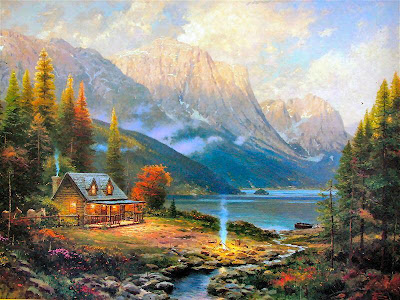 |
| New Fire and Ice by Thomas Mangelsen |
A few weeks ago, a friend asked me to take a look at
the images at the Thomas Mangelsen Images of Nature gallery in Las Vegas. These
images are not only visually stunning, they also seem to change with
different light levels and the gallery exhibited some of them in a
room with a dimmer to demonstrate this effect.
Most
of the images in the gallery were printed on silver halide photo
paper laminated to the back of a sheet of acrylic. This is a
beautiful way to mount a photographic print, but most of the visual
impact, including the interesting effect with the dimmer, was in the
original photography. These images will exhibit similar
characteristics when printed on high gloss metal or any other method
which has crisp and vibrant color reproduction.
 |
| Cypress Sunset by Thomas Mangelsen |
This
style of photography draws characteristics from a group of American
painters in the mid 1800s who painted landscapes and seascapes that
were infused with light. These “luminist” painters created works
that radiate light, whether from a window of a stone cottage or
through shafts of sunlight penetrating through the clouds. This was
was a favorite technique of the Hudson River School and was
incorporated into western landscapes by Albert Bierstadt and others.
 |
| Between the Sierra Nevadas by Albert Bierstadt |
Luminism
strongly influenced the popular “Painter of Light” Thomas Kinkade
who called his use of light the “Kinkade Glow.” He has explained
that his method for creating the glow relies on three visual aspects:
“soft edges, a warm palette and an overall sense of light.” The
effect is particular effective for Kinkade in suggesting romanticism
and nostalgia with a sense of mystery.
 |
| The Beginning of a Perfect Day by Thomas Kinkade |
To
emulate the Luminist style, your image should contain saturated
pastels, particularly the warmer shades of yellow and orange. The
edges of the image can be darker so the eye is drawn to the main
source of light and the reflections the light creates.
After
becoming familiar with this style of painting and photography, I
decided to dig through my own image archives looking for examples. I
believe these images of a sunrise over the Indian Ocean, which my wife
Terri captured last year in Mozambique, fit the description perfectly.
 |
| Indian Ocean Sunrise One by Terri Williams |
 |
| Indian Ocean Sunrise Two by Terri Williams |
I had some of these printed by Black River Imaging on 16x20 metal and tested the effect with
a light and dimmer in my dining room. The pictures really do change dramatically as the light level changes.
Try it for yourself and
see what you think!
You might also like:
You are right, these images are not only visually stunning, but they also seem to change with different light levels and the gallery exhibited some of them in a room with a dimmer to demonstrate this effect. Thank you for writing this playful piece of writing. I am associated with the Book fulfillment industry. I wish we were also able to visit places. In my opinion, seeing new places infuse confidence and creativity in us. It is an amazing feat in itself.
ReplyDeleteI am glad that you enjoyed the post. I also work in the book fulfillment field, supplying equipment for layflat book binding.
Delete